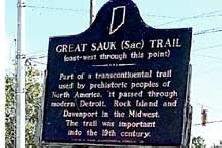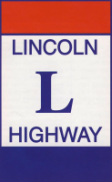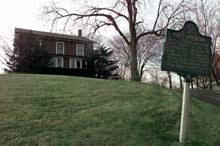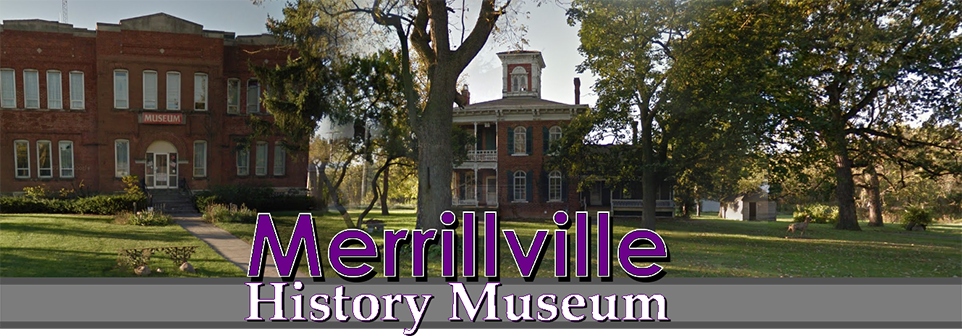LOCAL HISTORY

DID YOU KNOW?
Our own 73rd Avenue holds quite an important place in history? Our town thoroughfare roughly follows the Sauk Trail, an important pathway running between what is now Rock Island, Illinois and Detroit, Michigan. The trail is named for the Sauk Indians and was actually part of a network of trails used by various tribes nationwide for hundreds of years.
Later, settlers used this same roadway as a stagecoach route to cities such as Michigan City, Joliet, Detroit and Fort Dearborn (now known as Chicago). It was sometimes known then as the Joliet Trail. The road was also the route used by fortune hunters on their way to California during the Gold Rush of the late 1840s and 1850s. For a time, the local hotel here was named “The California Exchange Hotel”.
Our own 73rd Avenue holds quite an important place in history? Our town thoroughfare roughly follows the Sauk Trail, an important pathway running between what is now Rock Island, Illinois and Detroit, Michigan. The trail is named for the Sauk Indians and was actually part of a network of trails used by various tribes nationwide for hundreds of years.
Later, settlers used this same roadway as a stagecoach route to cities such as Michigan City, Joliet, Detroit and Fort Dearborn (now known as Chicago). It was sometimes known then as the Joliet Trail. The road was also the route used by fortune hunters on their way to California during the Gold Rush of the late 1840s and 1850s. For a time, the local hotel here was named “The California Exchange Hotel”.

Over the years, the street has been called by other names by locals, including, simply, "The Main Road"
When the first transcontinental highway was created in the late-1910s, 73rd Avenue was paved and became part of the famed Lincoln Highway. When that highway moved a few blocks south in the late 1930s, 73rd Avenue started being referred to as the “Old Lincoln Highway”. Its numerical designation also changed, from U.S 30 to County Road 330.
Other current Merrillville streets were once known by other names as well: 57th Avenue was Krieter Road and a portion of 61st Avenue was called Wehner Drive.
The Dr. Henry Palmer home, located near 73rd and Taney, was a stop on the Underground Railroad, a secret network helping escaped slaves reach safety that operated before and during the Civil War.
In the 1830s, Dr. Palmer was the first physician to settle in Lake County.
When the first transcontinental highway was created in the late-1910s, 73rd Avenue was paved and became part of the famed Lincoln Highway. When that highway moved a few blocks south in the late 1930s, 73rd Avenue started being referred to as the “Old Lincoln Highway”. Its numerical designation also changed, from U.S 30 to County Road 330.
Other current Merrillville streets were once known by other names as well: 57th Avenue was Krieter Road and a portion of 61st Avenue was called Wehner Drive.
The Dr. Henry Palmer home, located near 73rd and Taney, was a stop on the Underground Railroad, a secret network helping escaped slaves reach safety that operated before and during the Civil War.
In the 1830s, Dr. Palmer was the first physician to settle in Lake County.

In the 1920s and 30s, a street car line ran along Cleveland / Taft Street from Gary to Crown Point. In fact, the old Block House building at 62nd and Cleveland was originally a garage and barn for the old trolley line.
As a primarily agricultural community for many years, Merrillville / Ross Township was home to many dairy farms, such as Toney Smith’s near 57th and Harrison. With the coming of the railroad here in the 1870-80s, daily milk train routes were established. Several dairies were here, too, including the Seldom Idle Dairy, which was located on what is now Mississippi Street, and the Sunderman Dairy, located on what is the current U.S. 30.
In the days before television and Interstate highways, Merrillville had quite a few interesting tourist sites and local hot spots including Tierney's Steakhouse (now home to the Old Mill Pizzeria), Kitchel’s Lodge, Schmidt’s Bowling Alley and Halsted’s Dance Hall
Ever hear of Merrillville's Harding High School? Built in 1927-28 on the site of what is now Pierce Middle School, Harding High School was used a very short time before being completely destroyed in an October 1928 fire.
Four portable buildings were erected in order to conduct classes while a new school was constructed.
When the high school was rebuilt, it was named Merrillville High School. Despite many renovations, parts of this building still stands and is now Pierce Middle School. The new (and current) Merrillville High School at 276 E. 68th Place was opened in 1953.
As a primarily agricultural community for many years, Merrillville / Ross Township was home to many dairy farms, such as Toney Smith’s near 57th and Harrison. With the coming of the railroad here in the 1870-80s, daily milk train routes were established. Several dairies were here, too, including the Seldom Idle Dairy, which was located on what is now Mississippi Street, and the Sunderman Dairy, located on what is the current U.S. 30.
In the days before television and Interstate highways, Merrillville had quite a few interesting tourist sites and local hot spots including Tierney's Steakhouse (now home to the Old Mill Pizzeria), Kitchel’s Lodge, Schmidt’s Bowling Alley and Halsted’s Dance Hall
Ever hear of Merrillville's Harding High School? Built in 1927-28 on the site of what is now Pierce Middle School, Harding High School was used a very short time before being completely destroyed in an October 1928 fire.
Four portable buildings were erected in order to conduct classes while a new school was constructed.
When the high school was rebuilt, it was named Merrillville High School. Despite many renovations, parts of this building still stands and is now Pierce Middle School. The new (and current) Merrillville High School at 276 E. 68th Place was opened in 1953.
OTHER RESOURCES
Sources about Northwest Indiana History
1) The Calumet Region: Indiana’s Last Frontier
Powell A. Moore Indianapolis: Indiana Historical Bureau, 1959 (reprinted 1977, 1991)
2) Counties of Porter and Lake Indiana, Historical and Biographical
Weston A. Goodspeed, historical editor and Charles Blanchard, biographical editor
Chicago: F.A. Battey and Company, 1882
(The museum’s copy is actually a modern reprint from the 1960s)
3) Lake and Calumet Region of Indiana
Thomas H. Cannon, editor-in-chief, and H.H. Loring, Chas. J. Robb
Indianapolis: Historians’ Association Publishers, 1927
4) Encyclopedia of Genealogy and Biography of Lake County Indiana, 1834-1904
Rev. T.H. Ball, editor-in-chief Chicago and New York: The Lewis Publishing Company, 1904
5) Lake County Indiana From 1834-1872
Rev. T.H. Ball Chicago: Goodspeed Printer and Publisher, 1872.
6) Northwestern Indiana From 1800-1900
Rev. T.H. Ball Chicago: Donohue and Henneberry, 1900.
7) A Standard History of Lake County, Indiana and the Calumet Region
William F. Howat, editor Chicago and New York: The Lewis Publishing Company, 1915
8) Lake County Interim Report: Indiana Historic Sites and Structures Inventory
Historic Landmarks Foundation of Indiana, May 1996
9) Ross Township Cemeteries, Lake County, Indiana
Valparaiso: Northwest Indiana Genealogical Society, December 1995.
More Valuable Sources
Northwest Indiana Genealogical Society
http://www.nwigs.org/
Lake County Public Library - Merrillville Branch
Online and book resources.
http://www.lcplin.org/learn/FindInfo/genealogy.html
Seventy Third Avenue Revealed - The Great Sauk Trail
The Great Sauk Trail
Chuck Brown - A history of what would become the Lincoln Highway
Northwest Indiana Genealogical Society
http://www.nwigs.org/
Lake County Public Library - Merrillville Branch
Online and book resources.
http://www.lcplin.org/learn/FindInfo/genealogy.html
Seventy Third Avenue Revealed - The Great Sauk Trail
The Great Sauk Trail
Chuck Brown - A history of what would become the Lincoln Highway

